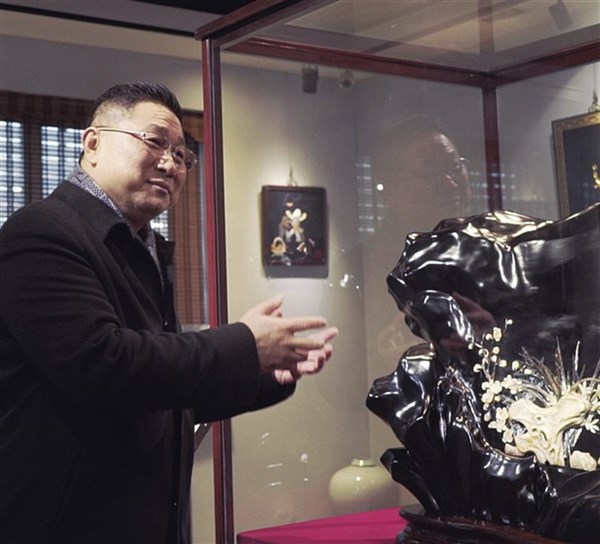今日上海
上海海派漆器艺术馆馆长:为历史创造记忆 - 2018年03月23日
A man’s crusade to protect vanishing art

WANG Shijun, founder of Shanghai Haipai Lacquerware Museum in Minhang District, shows visitors around with a passion hard to hide.
“Before being lacquered, the surface of the object is sometimes painted, inlaid with shell and other materials, or carved,” he explains. “The lacquer can be dusted with gold or silver.”
Once working as a civil servant, Wang resigned in 1994 to engage in trade.
In the late 1990s, he sponsored the students of a primary school in Yunnan Province. He says he wanted to pass on the kindness that he had received from others.
After turning a tidy profit from his trade work, Wang started to collect artworks and decided to stick to only one kind of art. He set his heart on Chinese lacquerware.
However, after inviting several masters in Shanghai to appraise his collection, he found that rather than collecting these works, he had a more urgent task to do: He should be a guardian of such art.
He learned that despite the long history and intricate techniques involved, lacquerware has got less attention from people than other art forms. And some masters are confronted with the predicament of nearly being out of work.
“I had to do something,” Wang says in a solemn tone. “I love lacquerware and I want more people to get to know it.”
So in 2010, he started the preparation for a museum, which opened in 2013. It’s a place where people can enjoy more than 1,000 pieces — from the traditional to the contemporary. There are also studios for eight masters to carry on preservation research.
After applying for Shanghai’s intangible cultural heritage, Wang and the eight masters went on to revive Shanghai lacquerware by combining tradition and innovation.
There was a time when as a collector, Wang took pleasure in collecting what he wanted. But now, as a curator, he says the happiest moment came when a piece of lacquerware — the fruit of their painstaking work — won the top award in an art and craft contest. “Being recognized and acknowledged satisfies me most.”
Speaking of the unique characteristic of Shanghai lacquerware, Wang mentions the spirit of the city: “The sea refuses no river.” In other words, embracing diversities. Such is the character of Shanghai and Shanghai lacquerware, whose creators are always open to new ideas.
According to Wang, different regions in China are known for their own lacquer-processing techniques. Shanghai artisans are famous for selecting the refined and discarding the crude from these different styles, helping local lacquerware to keep on improving.
After the maintenance of the museum, Wang plans to make a bit of a change. On the first floor, an area for DIY is set up for visitors — young and old — to try lacquerware-making themselves. On the fifth floor, an audio-visual classroom is prepared for lectures, training and group discussions.
“The masters are getting older and older,” Wang says. “What is urgent for us now is to recruit young people who have talent, passion and persistence.”
Wang says his lacquerware museum is cooperating with some colleges to attract more students, provide them the opportunity to get close to the art and foster the future masters.
But that’s not going to be an easy task.
“To pass on this cultural heritage,” he explains with a sparkle in his eye, “we have to first attract people’s attention and get them to understand it.”
Shanghai Haipai Lacquerware Museum
Address: 1688 Jidi Rd
How to get there: Take Metro Line 2 to Songhong Road and transfer to bus No. 74 heading Huaxin Town. Get off at Jidi Road and Jimei Road.
